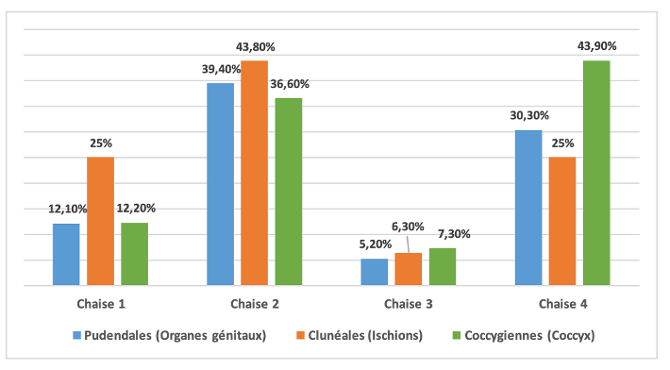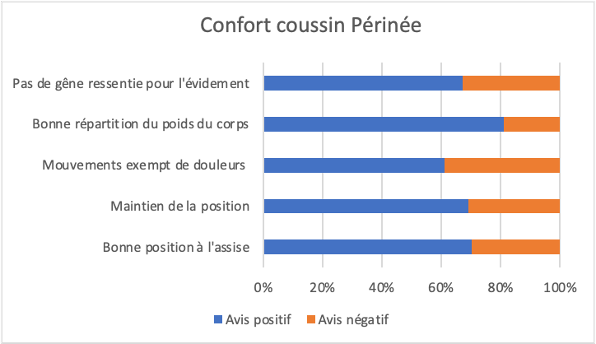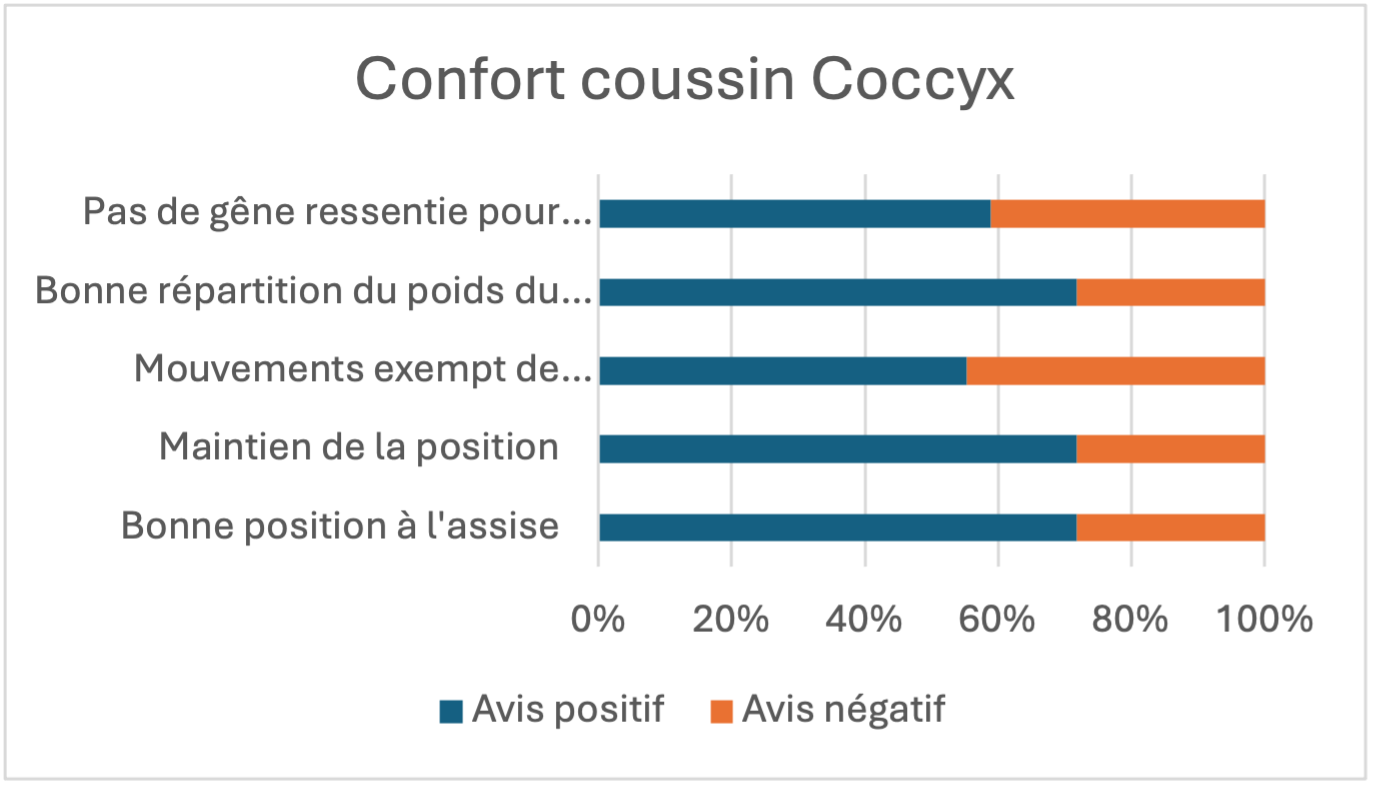The study pelvic floor Seat, led by the CHU of Nantes assesses the effectiveness of the cushions ergonomic Aporia® compared to chairs traditional to relieve pain in the pelvic floor perineal, coccygeal and back. Find out in this synthesis the results that show the improvement of the comfort and a reduction of pain through the cushions Aporia®.
Gil Ayache – Blue Lift – February 20, 2024
Prior warning by Blue Lift : It is important to note that the time of the test used in this study only allows to measure a felt immediate. As with any solution, ergonomically, adjusting seats and the learning of their use, are essential to ensure optimal comfort and long-lasting relief. Like a shoe that must adapt to his foot, the use of ergonomic seats Aporia® requires a period of adaptation. It is why we offer a trial period of one month, after which more than 80 % of our customers choose to keep their seat Aporia®.The tests were not included shims adaptive normally provided with the cushions Aporia®. These shims allow a custom fit to the profile birth canal-spinal fluid of each user. Their absence may be an under-estimate the actual effectiveness of airbags in terms of comfort and reduction of pain.
BACKGROUND AND GOAL OF STUDY pelvic floor SEAT at THE CHU OF NANTES : to ALLEVIATE THE PAIN, pelvic floor PERINEAL, COCCYGEAL AND LUMBAR
Neuralgia pudendale, pain in the tailbone and low back pain : incapacitating diseases in a sitting position
The pain associated with the pudendal nerve (neuralgia pudendale), the nerve clunéal (neuralgia clunéale) and coccyx (coccygodynie) are common in patients followed at the university hospital of Nantes. These pains are often accompanied by low back painand they make it difficult to maintain a prolonged sitting position, thus affecting the quality of life of patients in daily activities such as meals, travel, or work.
The medical recommendations include the use of an ergonomically-shaped seat to relieve pressure points and painful, as well as a postural effective for reducing tensions in sensitive areas.
Why choose cushions ergonomic Aporia® to relieve the pain, pelvic floor perineal and coccygeal ?
On the basis of the preliminary tests carried out in 2022, cushions Aporia® are distinguished by their ability to provide a postural support dynamic and a pressure relief in the painful areas, such as the pudendal nerve and the coccyx. Designed around a flexible structure and multiarticuléethese cushions ergonomic fit to the movements of the user, ensuring long-lasting comfort.
Although the cushions Aporia® shall not be considered as medical devices, they are specifically designed for relieve the pain in the sitting areas in the pelvic, coccygeal and perinealwhile offering all-day comfort for people suffering from chronic pain.
Methodology of the study pelvic floor-Seat : comparative assessment of seated ergonomic Aporia®
In order to measure the effectiveness of cushions Aporia® compared to the foundation of traditional study was to test four types of bases :
- A foundation that lasts (Chair 1),
- A seat pad (Chair 3),
- A cushion Aporia® designed to relieve pain in the perineal (Chair 2),
- A cushion Aporia® dedicated to pain, coccygeal (Chair 4).
Each patient has tested this foundation for 15 minutes, and then responded to a questionnaire assessment. The evaluation criteria included the perception of pain, comfort, postural support and the discretion of the device.

Characteristics of the study population : representative sample of patients suffering from pain pelvic floor perineal
The study was conducted with 95 patients. The population was predominantly female (82 %) with a median age of 45 years. 55 % of the participants had a BMI standard, while 40 % had a high BMI, including cases of overweight and obesity. All patients were suffering from pain pelvic floor perineal, with a majority reporting of pain in the coccyx (65 %), the pudendal nerve (50 %), and the nerve clunéal (25 %). The diversity of profiles ensures that the results are representative of patients with such pain.
MAIN RESULTS OF The STUDY pelvic floor-SEAT : SATISFACTION, PERCEIVED PAIN, AND PREFERENCES OF the USERS
Previous use of cushions ergonomic : dissatisfaction with the existing solutions
Among the participants, 47 % already being used by a cushion-ergonomically designed to sit, but only 11 % were satisfied with their cushion today. The majority of users (64,4 %) hoped to have a greater reduction in pain, while 42 % were looking for an improvement of the ergonomics, 25 % superior comfort and 20 % better postural support. In addition, 27 % of the users gave a great importance to the discretion the device, indicating the need for a cushion adapted to the professional environments and social.
General Satisfaction with the cushions ergonomic Aporia® to relieve the pain in the coccyx and the pudendal nerve
The results revealed a dissatisfaction significant vis-à-vis chairs traditional, with rates of dissatisfaction 69 % for the chairs, hard 79 % for the chairs fleece. In other hand, the cushions Aporia® have been widely appreciated : version coccyx collected 63 % of satisfaction, while the version perineum got 59 % satisfaction. These results are particularly notable, given the prevalence of pain, coccygeal among the participants.
Significant reduction of pain thanks to the cushions Aporia® : effectiveness on the pain, coccygeal and perineal
A majority of the participants found the chairs are hard and fleece painful (69 % and 79 %), but the cushions Aporia® significantly reduced the perceived pain : 45 % users have not felt any pain with the version coccyx, and 38 % have noted a reduction in pain with the version perineum.
Preferred choice of users : the cushions Aporia® widely acclaimed
The cushions Aporia® has dominated the rankings of satisfaction. Version perineum got 77 % of the vote among the top two positions, while the version coccyx collected 67 %.
The main reasons for this choice include the reduction of pain (73 %), the postural optimized (43 %), and theergonomics (40 %).

Extended comfort cushions Aporia® : significant improvement, but limits on the duration
After a first phase of tests short, the patients performed a test is extended to 4 minutes on the cushions Aporia®. 54 patients preferred version perineum, and 40 chose the version coccyx. The overall improvement of the comfort has been observed, with positive reviews from 65 % to 80 % for the version perineum and 58 % 70 % for the version coccyx. However, discomfort have been noted after an extended period of time : 63 % users of version perineum and 53 % those of the version coccyx reported discomfort after 4 minutes of sitting.


Perception of the course : of mixed mind on the cushions ergonomic Aporia®
The hollowing out of the cushions, designed to relieve pressure on sensitive areas, has been perceived as annoying by 31 %users of version perineum and 40 % those of the version coccyx. The majority (59 % to 69 %) felt that the course was not wide enough, this could explain this embarrassment1.
Amplitude and smoothness of movements : the cushions Aporia® make travel easier
The cushions Aporia® were found to be very effective for ease of movement. Only 12 % users of version perineum and 17 % those of the version of coccyx have been reported limitations in range of motion. About ease of movement, 92 % users to the version perineum and 83 % for the version of coccyx have been reported and fluid movements without effort.
Conclusion made by Blue lift : Our commitment to ergonomics, long-lasting relief from pain, pelvic floor perineal and low back pain, and the long-term comfort. The results of the study pelvic floor Seat show that the cushions ergonomic Aporia® provide a significant relief of pain pelvic floor perineal and coccygeal, with a significant reduction of discomfort associated with prolonged sitting. Thanks to their structure multiarticulée that combines postural support dynamic and reducing pressurethese cushions meet the expectations of users in terms of comfort, of pain relief and mobility. Our Blue Portancewe are convinced that our cushions ergonomic Aporia® are an effective response to the pain related to complex pathologies such as neuralgia pudendale, neuralgia clunéale, the coccygodynie or low back pain. The high rate of satisfaction and the positive feedback from our customers after a trial period confirm the importance of a progressive adaptation to fully benefit from the therapeutic effects of our products.Our commitment : to continue to innovate and provide ergonomic solutions that contribute to the improvement of the quality of life of people with chronic pain.
- Drawing lessons from these results, the recesses have been reviewed by conducting a series of measurements of anatomical in-office gynecological to optimize the cut-aways ↩︎



Hello, I bought a cushion Aporia in June, and for me this is only happiness.
I'm considering buying the chair with a cushion, I'll have a quote to be able to ask for support to the MDPH.
Thank you for this research and be able to give us back a seating comfort which enables us to live an almost normal life
Bonjour Madame Favre, we are pleased to learn that this allowed us to find a course of life more normal. This encourages us to move forward. We will provide you with a quote for the MDPH as soon as you have chosen a seat in our new range.